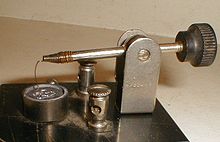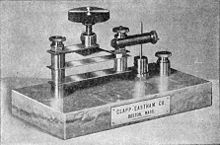

A crystal detector is an obsolete electronic component used in some early 20th century radio receivers that consists of a piece of crystalline mineral which rectifies the alternating current radio signal and was employed as a detector (demodulator) to extract the audio modulation to produce the sound in the earphones. It was the first type of semiconductor diode, and one of the first semiconductor electronic devices. The most common type was the so-called cat whisker detector, which consisted of a piece of crystalline mineral, usually galena (lead sulfide), with a fine wire touching its surface. The "asymmetric conduction" of electric current across electrical contacts between a crystal and a metal was discovered in 1874 by Karl Ferdinand Braun. Crystals were first used as radio wave detectors in 1894 by Jagadish Chandra Bose in his microwave experiments. Bose first patented a crystal detector in 1901. The crystal detector was developed into a practical radio component mainly by G. W. Pickard, who began research on detector materials in 1902 and found hundreds of substances that could be used in forming rectifying junctions. The physical principles by which they worked were not understood at the time they were used, but subsequent research into these primitive point contact semiconductor junctions in the 1930s and 1940s led to the development of modern semiconductor electronics.
The unamplified radio receivers that used crystal detectors were called crystal radios. The crystal radio was the first type of radio receiver that was used by the general public, and became the most widely used type of radio until the 1920s. It became obsolete with the development of vacuum tube receivers around 1920, but continued to be used until World War 2. https://en.wikipedia.org/wiki/Crystal_detector
